20+ Types of Kitchen Knives
When you buy through our links, The Breslin may earn an affiliate commission. Learn more
Have you ever looked at a knife set and wondered, “What types of kitchen knives are they, and how to use them?” You want to know if they’re suitable for your needs and worth the money.
This ultimate guide will give you what you need to use your knives. Now, you don’t need to worry about all the knives that take up all the space in your utensil drawers that you’ll hardly ever use and only buy the ones that are most suitable for you.
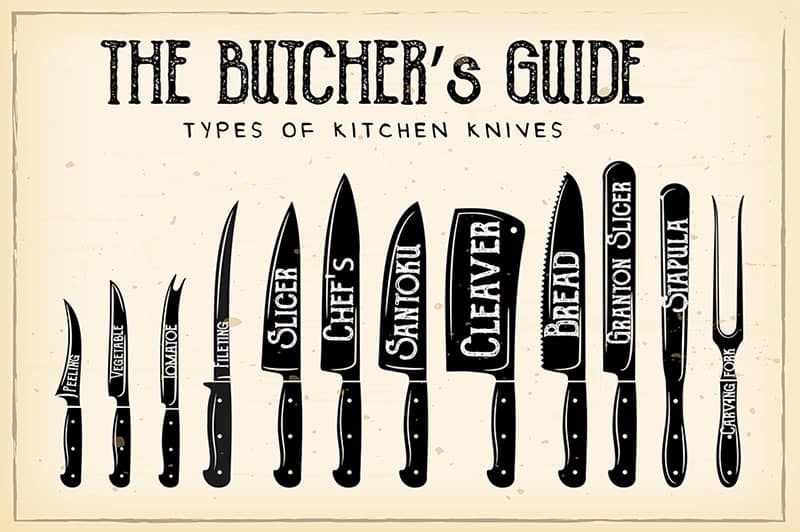
What Is A Knife, And What Can You Use It For In A Kitchen?
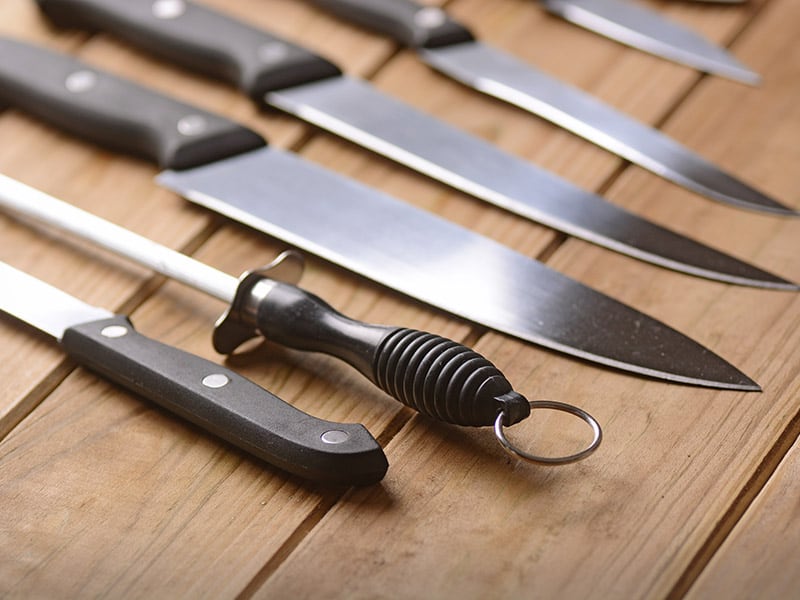
A knife is a utensil with a handle and a piece of metal attached to the handle. It can be in various shapes and types with different features and uses. In the kitchen, a knife is for cutting, chopping, mincing, dicing, slicing, and many other kitchen tasks.
Some knives have special features and can be used for specific purposes, like boning or carving. Other knives are for table setting, like a steak knife, fish knife, cheese knife, or butter knife.
2 Main Types Of Knives: Based On Their Features
The first thing you may have heard about knives is if this is a stamped knife or forged. The two types are different in manufacture, and both have pros and cons.
What are the differences? This table will show basic information, each type’s advantages, and disadvantages.
1. Forged Knife
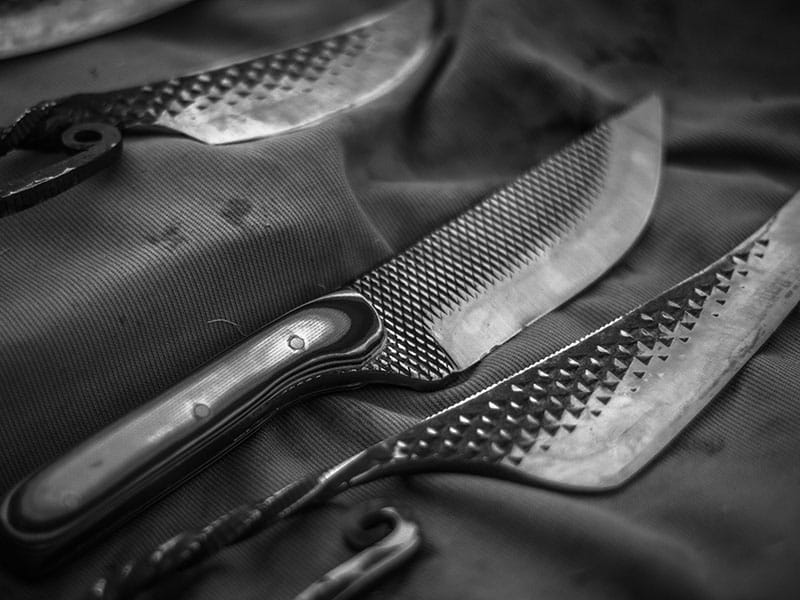
The making of a forged knife consists of a whole bar of steel and an added bolster connecting the heel and the handle.
Forged knives are usually heavier, thicker, and stronger than stamped knives. They also have better balance than stamped knives because of their full tang.
Many cooks love forged knives for their sturdy weight and the power they bring to each cut. The precision that forged knives bring to the cut is another reason people choose them.
Forged knives are also safer to use since they add an extra layer of protection for your fingers with the bolster.
Forged knives are usually more expensive than stamped knives because of their intensive and time-consuming making process, which is why they also last longer.
A closer look at how a knife smith forges a kitchen knife.
2. Stamped Knife
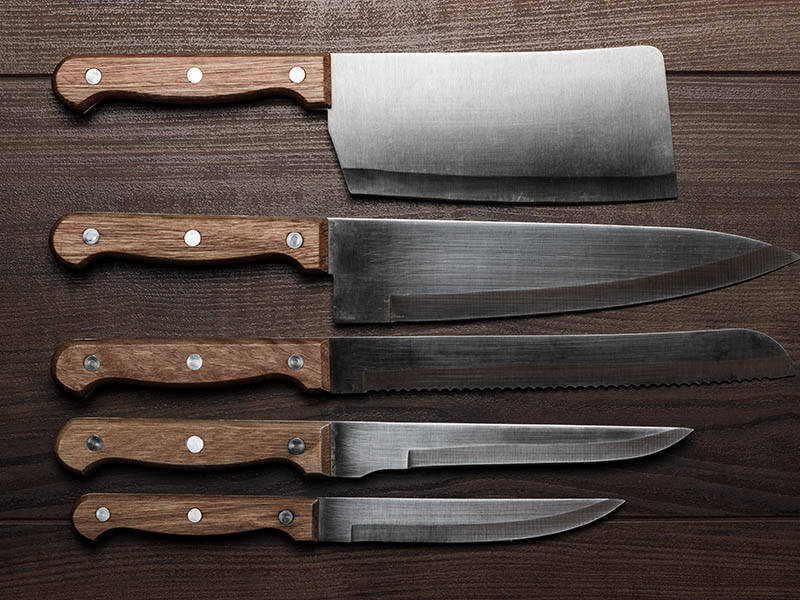
The stamped knife is a familiar item in home kitchens, with its lower price and a lighter feel on the hand. Usually thinner, stamped knives have more flexibility. Its thin blade is perfect for slicing and cutting more delicate pieces of ingredients.
They make stamped knives by cutting a big steel sheet, then honing and heat-treating for greater stability. A stamped knife usually doesn’t have any bolster. The heel of the knife is attached to a handle.
However, because of its thinness, a stamped knife is not as long-lasting as a forged knife. It can get dulled easier and need more sharpening. In some cases, the handle can break off as well. A stamped knife has a smaller tang causing it to have less balance than a forged knife.
The 4 Must-Have Types Of Knives For Any Kitchen
Even if you’re a professional cook, a home cook, or a new-to-the-kitchen type, you should always have essential cutting tools in the kitchen. In this section, you’ll see how these 4 types of knives can do a vast majority of tasks in the kitchen.
3. Chef’s Knife
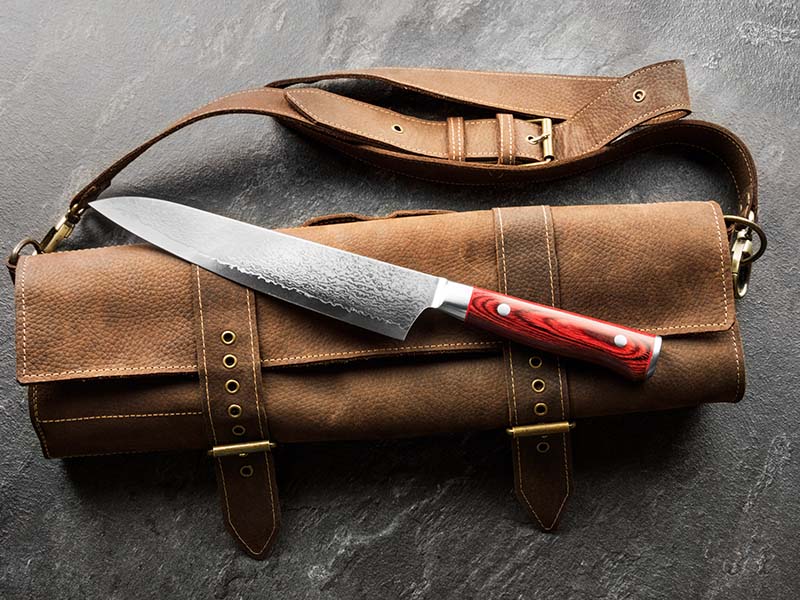
You can recognize a chef’s or cook’s knife in any professional or home kitchen.
It has a broad, long blade with a straight edge and tapering to a point. Measuring around 6 to 14 inches long, you can choose the suitable chef’s knife size for your hand.
With its versatility, the chef’s knife is well-loved by many professional and amateur cooks. The long blade with a slight curve allows you to chop and dice multiple pieces of vegetables or meat at once on a cutting board.
Moreover, the pointy tip of the knife can make cutting through chicken bones or disjointing large pieces of beef – all the heavy-duty tasks – a lot simpler.
Even though the chef’s knife is versatile, it’s quite hard to use on small vegetables and fruits since the blade is big, so it cannot offer precise cuts.
Some comparisons between different types of chef’s knives that you may need.
4. Utility Knife
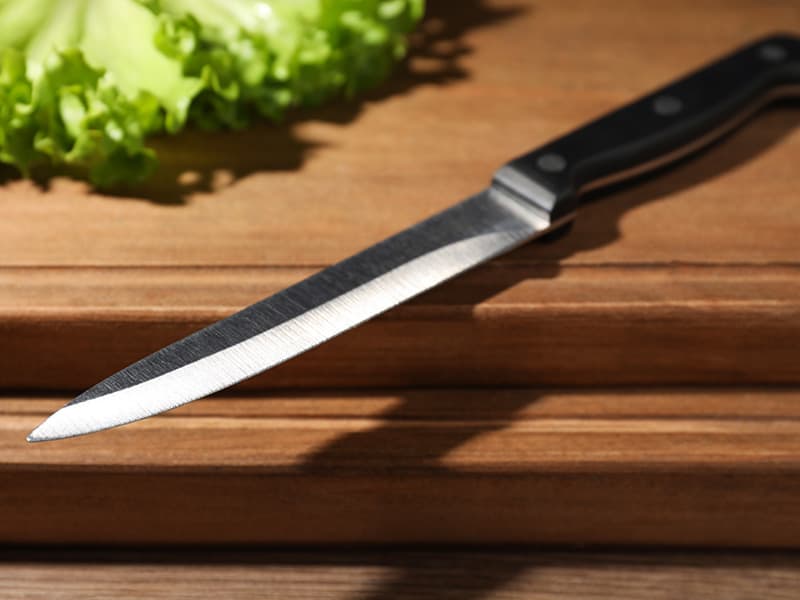
A utility knife is a smaller version of a chef’s knife; sometimes, it can have a more narrow blade with a sharper tip. At just 4 to 7 inches long, this type of knife is perfect for more detailed work.
This knife can have either a serrated or straight-edge blade. A serrated-edge utility knife is perfect for cutting bread and sandwiches, like a bread knife. A straight-edge one is suitable for peeling vegetables.
As a Jack-of-all-trades in the kitchen, a utility knife is used for numerous tasks. A utility knife is a lifesaver, especially for jobs requiring more details, such as slicing and cutting smaller vegetables, fruits, and tender pieces of meat.
If your food is too small to use a chef’s knife, you can always reach for a utility knife to do the work. It’s easy to take anywhere you want, like on a trip or camping.
5. Paring Knife
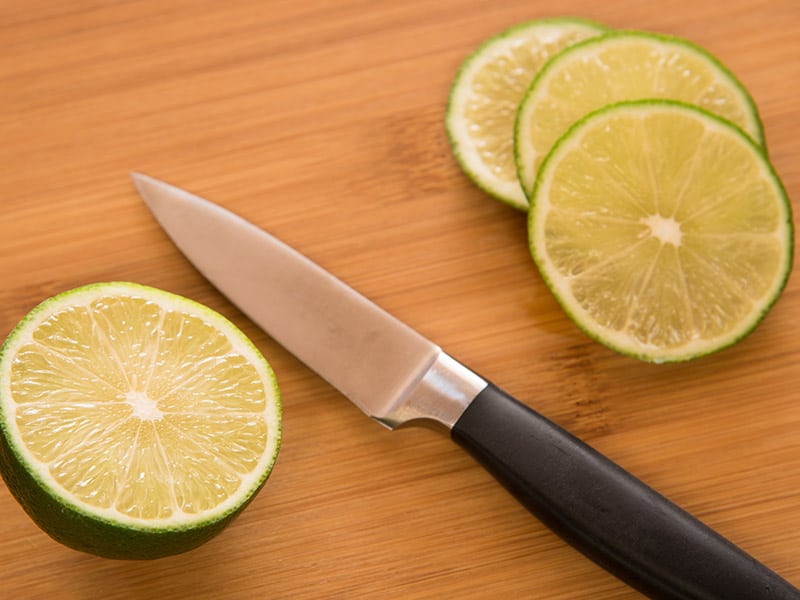
A paring knife is one of the most versatile tools in the kitchen. This small kitchen knife is a duplicate of a chef’s knife, with a shorter blade (2 to 4 inches) and a pointed tip. You can easily handle more complicated work with how light it is on your hand.
Paring knives are popular with 3 main types: classic, sheep’s foot, and bird’s beak, according to the knives’ tips.
Despite its small size, a good paring knife have many uses in the kitchen. For example With this knife, you can easily cut, chop, or slice small vegetables and fruits. Moreover, a paring knife is ideal for trimming and peeling vegetables and fruits that need perfect precision.
The blade is thin and light, so I wouldn’t recommend you to choose this knife to cut hard vegetables, like carrots, squash, etc. A paring knife is also not an alternative for other small knives, like a vegetable knife, boning knife, or filleting knife.
6. Bread Knife
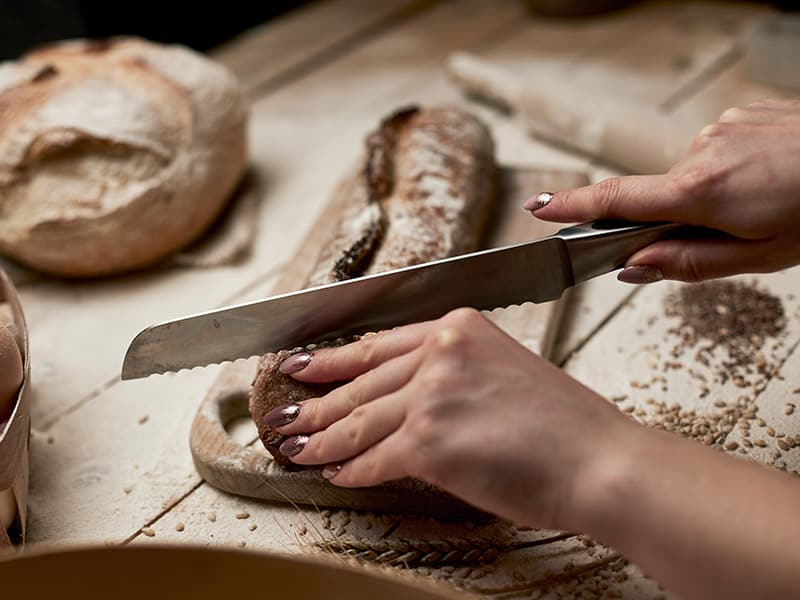
You can recognize a bread knife anywhere with its long, sharp, serrated blade, about 6 to 10 inches long. The serrated edge makes cutting through a loaf of bread easier without tearing it apart.
The bread knife also has an offset handle type, making cutting easier. It allows you to easily cut through the ingredients without having your fingers touch the cutting board.
You can guess it: a bread knife is for cutting bread. You can use it for any kind of bread and cakes, including bagels, baguettes, bread rolls, or crusty bread. If you don’t have a cake leveler on hand, you can always use this knife to level your cake.
Besides bread, you can use bread knives with softer vegetables and fruits since they won’t crush these veggies’ inside. But be prepared that the cut won’t be as clean as any straight blade knife.
To keep a bread knife sharp, you need special tools to sharpen it, which can take some time. But once done, it’ll bring such enjoyment to you.
You might want to know this technique to make a bread knife.
The Specialized Types Of Knives To Fit Each Purpose
If you are wondering: “What should I put next in my knife collection?” or if you want to find a specific type of knife for a particular purpose, this next section is for you.
Best Types Of Knives For Meat
To properly prepare meat, you need particular types of knives for that. In this part, I’ll introduce what knives are perfect for meal prepping, differentiate each of them for you, and what dishes you can make with that particular knife.
7. Carving Knife
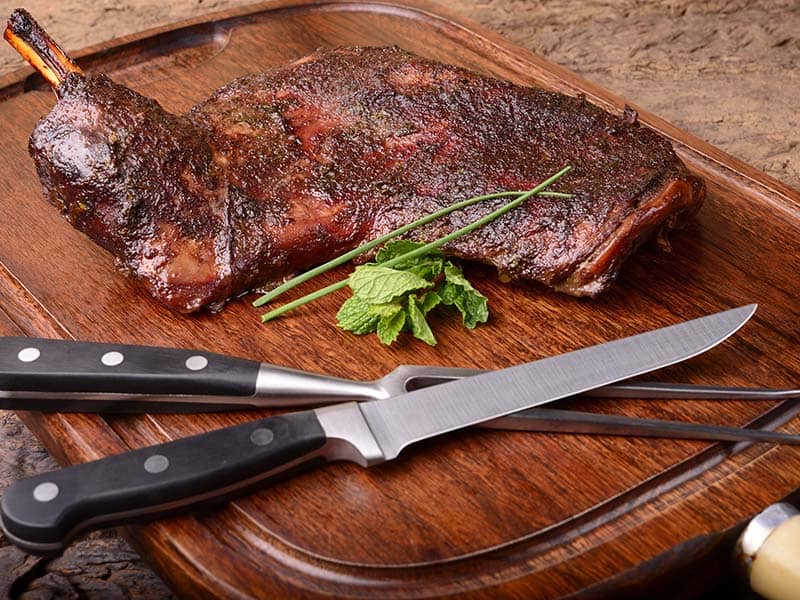
At first glance, a carving knife looks a lot like a chef’s knife. However, it’s slender and narrower, making your cut cleaner and sharper. It’s usually 8 to 15 inches in length.
Sometimes called a slicing knife, this is perfect for dishes that need finer, more uniform cuts of meat, like ham, turkey, or beef roast. The thin blade knife’s smooth slide can create beautiful pieces of meat, either thin as paper or thick and juicy.
The sturdy, long blade and pointed tip are suitable for cutting through bigger fruits and vegetables. It’s also suitable to cut cakes in one swift motion.
8. Cleaver/ Butcher Knife
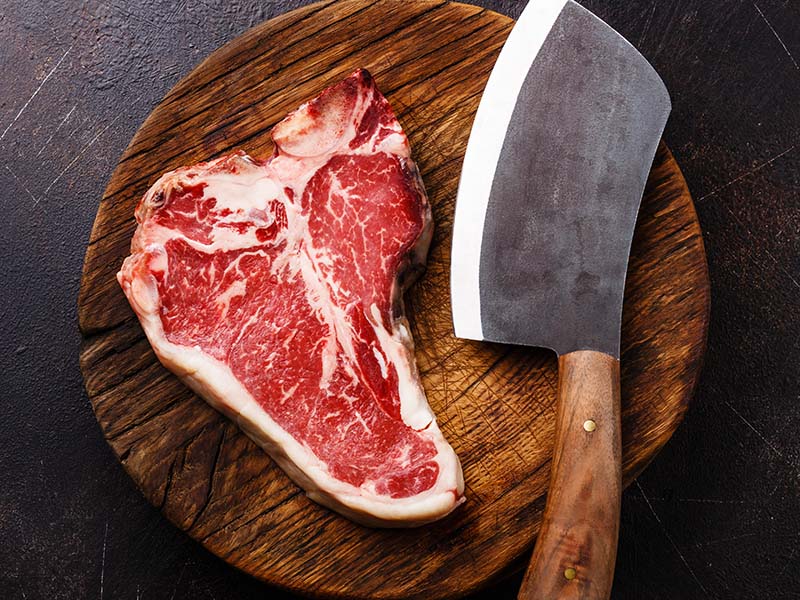
A cleaver, also called a butcher knife, is the bulkiest and heaviest cutting tool in the kitchen. While some people may not know this type of knife well, cooks in Asian kitchens usually use butcher knives. It has a flat, rectangular-shaped blade and a thick spine.
Different from other knives, a cleaver has a particularly strong edge so that it can repeatedly endure the blow you deliver to cut through meat bones and thick meat in a chopping motion.
Even though cleavers can look intimidating sometimes, they come in various forms and sizes, so you can choose one that is appropriate for you. A big blade can be harmful if used wrongly.
A cleaver can make chopping bones and hard vegetables like pumpkins or coconuts easier without adding more weight to the hand and wrist. The wide blade of a cleaver is a great tool for crushing garlic or onions, whereas other knives with thinner blades can crack under pressure.
You should hang a cleaver on a wall to keep it from damaging and getting dull with a top corner hole of the blade.
If you’re unsure how to hold a cleaver, this guide will give you some tips!
9. Boning Knife
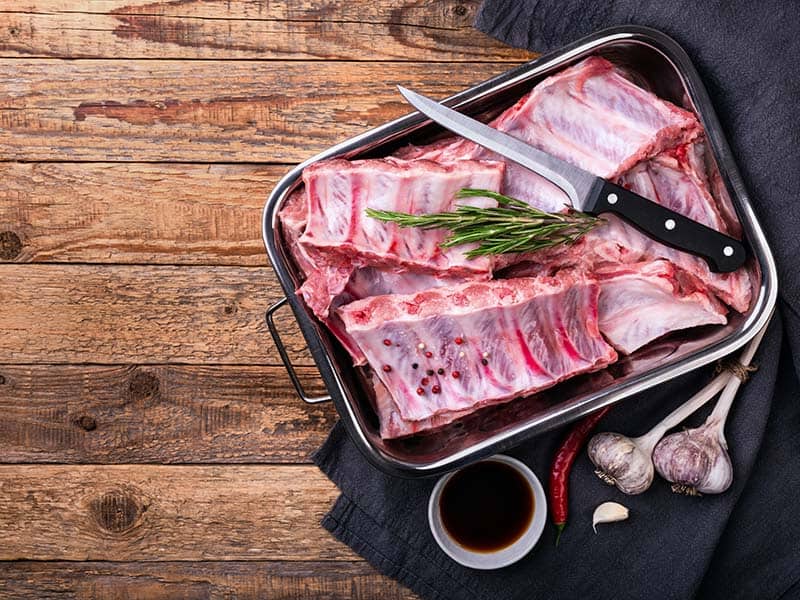
The boning knife has a rather short blade with a slight curve, a sharp edge, and a pointed tip. It’s usually five to six inches long.
The boning knife, as its name suggests, is for separating the meat of the bones and leaving behind as little meat as possible. And remember, this is for cutting meat off the bones, not through the bones.
A small boning knife is also an alternative to a paring knife, so you can use it to peel and cut vegetables.
There are 2 small categories of boning knives: rigid, stiff blade, and flexible blade, and both can be in a chef’s knife collection.
You can use stiff boning knives for thick pieces of meat to effectively cut through the connective tissue and joints without struggling. Flexible blades are suitable for removing skin and bones from poultry and fish.
Best Types Of Knives For Fish
If you are a big fan of fish, sushi, sashimi, or any seafood dish, equipping your kitchen with a fish knife is a great idea.
Fish knives vary for different purposes, from deboning, fileting, or descaling. These types of knives will make your life in the kitchen simpler, faster, and safer.
10. Filleting Knife
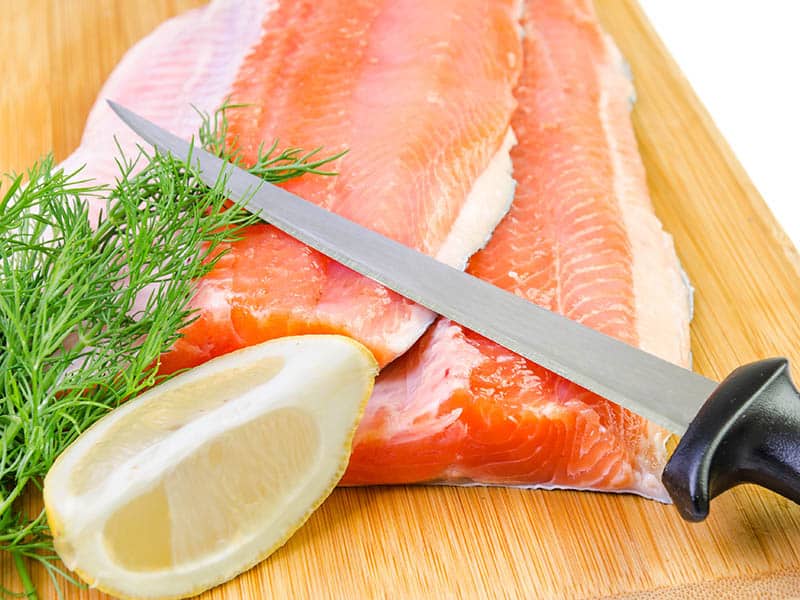
A filleting knife is quite similar to a boning knife but has a slimmer and thinner blade, enhancing its flexibility. It’s usually 6 to 11 inches long.
The blade must be flexible and thin, so it can be maneuvered through bones while keeping an edge. You use the knife at a horizontal angle, not vertical, which offers a clean cut at the backbones of the fish.
Fish have very delicate flesh, more so than meat. Using a filleting knife can help you remove bones easily without destroying the beauty of the fish. The filleting blade offers perfect control and precision to maneuver through the deboning process for an ideal fish filet.
The easiest way to filet a fish with a filleting knife.
11. Salmon Knife
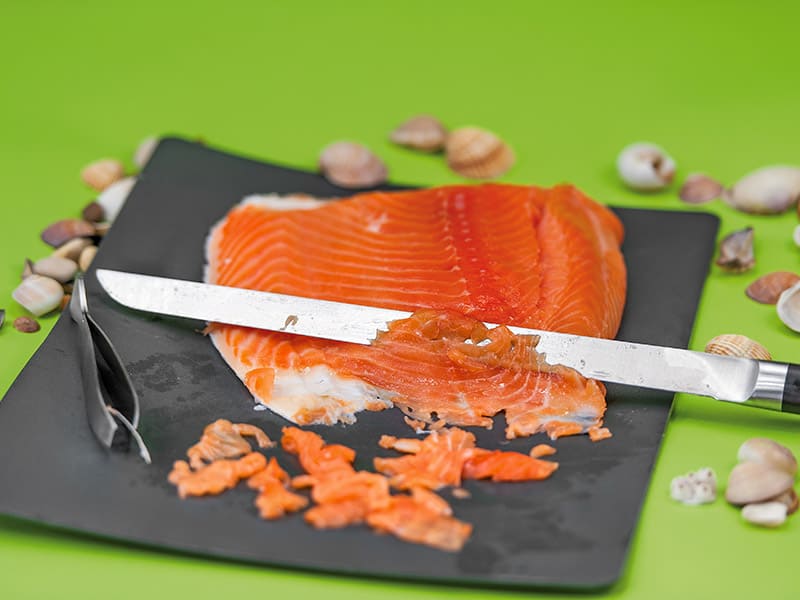
Its impressive blade length is a special characteristic of the salmon knife: at least 12 inches long.
The knife’s design is for cutting larger and longer fish, such as salmon and tuna. Like many other long-and-thin-blade knives, the salmon knife provides a paper-thin cut easily without tearing the fish meat apart.
Some salmon knives also have dimples along the blade, so you don’t have to worry about the fish meat stuck to the blade or the meat stuck on the skin.
A salmon knife is perfect for slicing and de-skinning bigger fish. Its slender blade lets you move the knife between the filet and the skin. You can have the cleanest and tidiest fillets with just this knife.
12. Santoku Knife
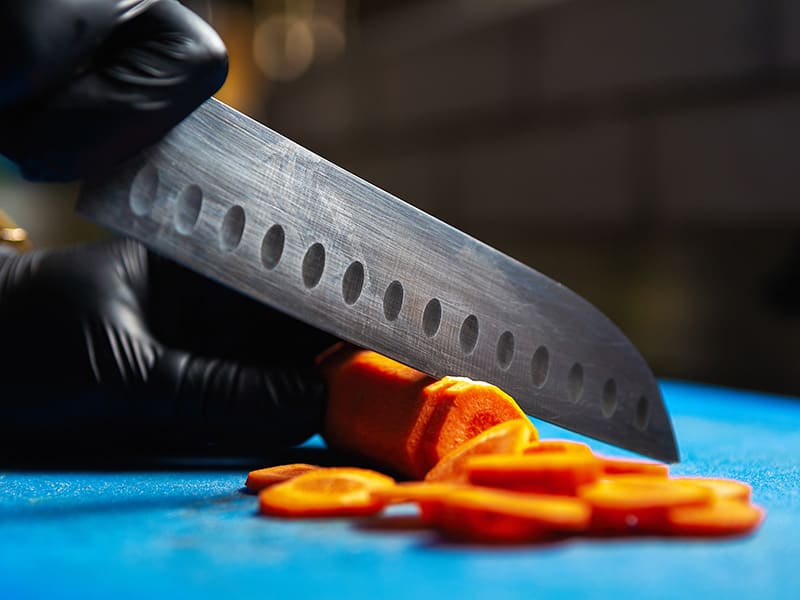
Many say a Santoku knife shares several similarities with a chef’s knife. It’s originally from Japan and is widely used in Japanese kitchens. Its long flat drop-point style blade allows the cook to make more precise and intricate work on the ingredients.
The thin blade of a Santoku knife and dimples on the flat side allow lean cuts of fish, as it helps prevent the meat from getting stuck on the metal blade.
A Santoku knife is just as versatile as any typical chef’s knife. “Santoku” means “three virtues” or “three uses” of the knife: mincing, dicing, and chopping. It can do almost all the tasks associated with food preparation as a replacement for a chef’s knife or utility knife.
Santoku knife has a straight, flat edge blade, so it’s unsuitable for mincing ingredients. However, it’s a great tool for slicing thin pieces of veggies.
Best Types Of Knives For Vegetables
Of course, you can use your chef’s knife or paring knife to prep your vegetables. However, you can always go for knives that are the most suitable for vegetables if you want to splurge in their kitchen knife set a bit more.
Upgrade your cooking experience with vegetable-specialized knives. Why not?
13. Nakiri Knife
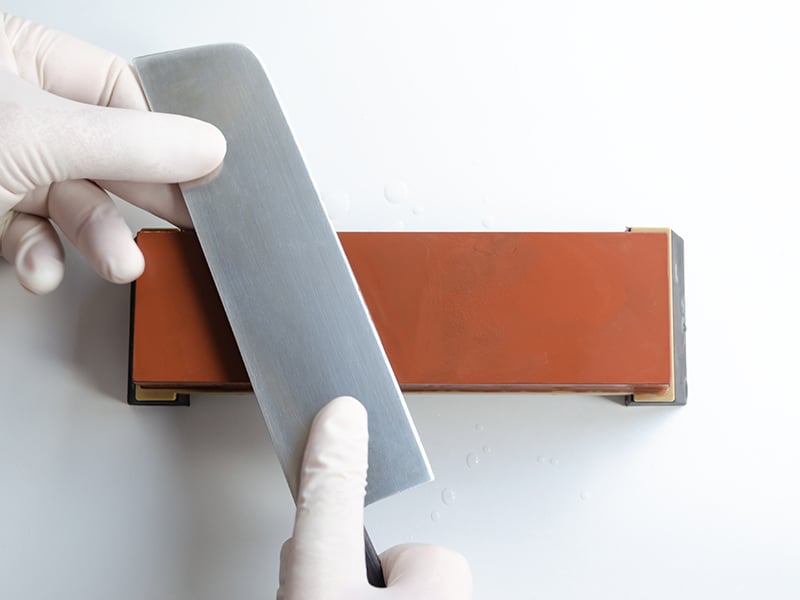
Nakiri knives are a slimmer and smaller version of a cleaver. The blade is a rectangular shape, thin with a square-like tip.
The Nakiri knife is one of the most unique knives, especially for cutting vegetables. Its blade quickly chops the vegetables without requiring too much force.
From small veggies, like tomatoes and cucumbers, to bigger and harder veggies, like potatoes or squashes, Nakiri knives can easily cut through them.
It also allows you to make precise and decorative cuts on fresh products with its sharp and thin blade. You can create beautifully thin slices of vegetables to add to your dishes as garnishment.
An in-depth instruction on using the Nakiri knife.
14. Tomato Knife
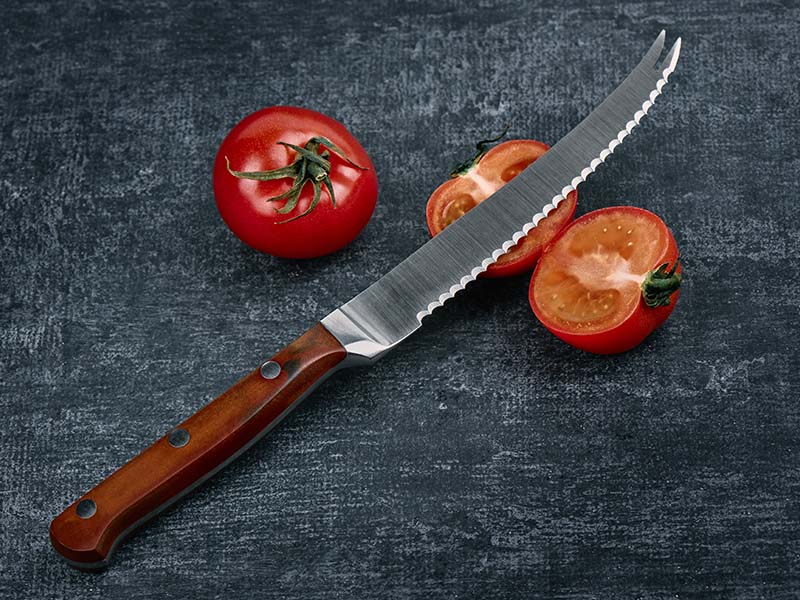
A tomato knife is a small serrated knife, about 6 to 7 inches, designed to specially cut tomatoes. The serrated edge of the knife allows you to cut through the tomatoes without using too much force, which can crush the mushy part of the tomatoes.
A tomato knife usually has a coarse plastic handle or rubber so you can have a better grip on the knife. You can use the fork-like tip, which some tomato knives have, to lift each piece of tomato onto a plate after cutting.
Any straight blade can cut the tomatoes just fine. However, a dull blade can make the cut difficult, which may, then, destroy the flesh. The saw-like motion when using the tomato knife puts less pressure on the tomatoes, helping them keep the shape of the tomato slices.
15. Peeling Knife
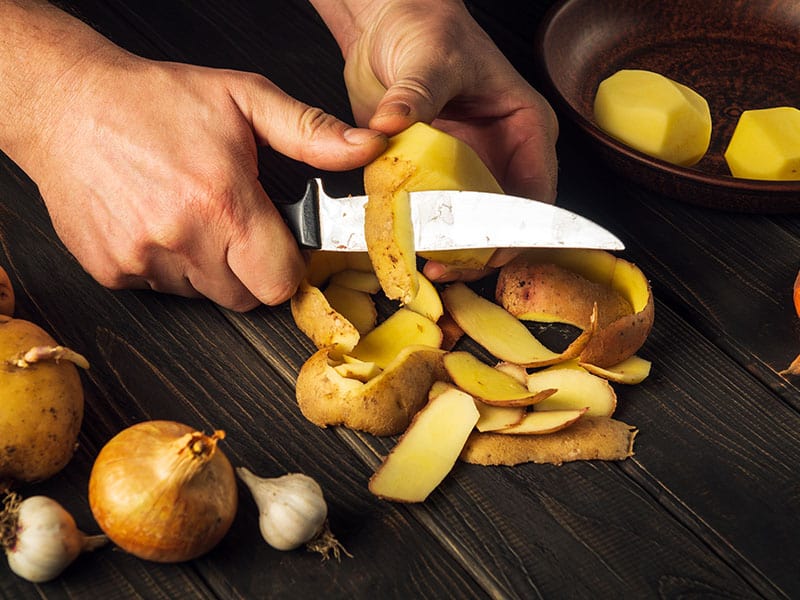
One of the shortest knives, the peeling knife has a curved blade and a straight, exceptionally sharp edge.
As its name implies, a peeling knife is a peeling tool in the kitchen. You can use it to peel and slice through the tough skins of vegetables, such as potatoes and fruits.
The peeling knife has a sharp and rigid blade and a sturdy handle, so you can have a good grip on the knife, making the peeling process easier and safer.
A peeling knife is useful to use if you want to make garnish as decorative elements for your dish. You can also cut soft fruits and trim vegetables with it.
What About Table Cutlery?
Table etiquettes for dining have been in history for thousands of years, and now, in the modern-day, those etiquettes are still in use, and so is the cutlery. Here are some knives you can find on a dining table at restaurants, social events, or home.
16. Steak Knife
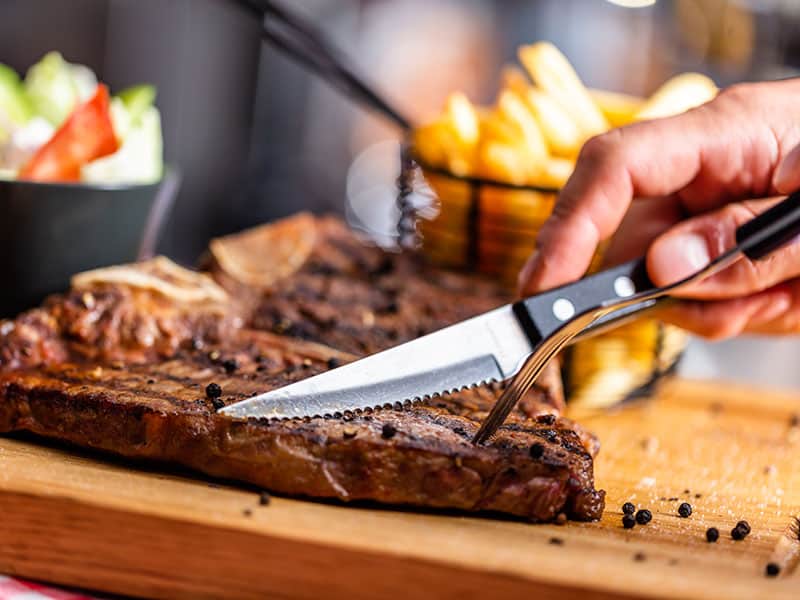
A steak knife is a type of table knife that has a pointed tip and either a straight or serrated edge. This specific type of knife’s design helps you cut through cooked meat easily, even with thick pieces of meat.
This serrated blade can be of many uses in the kitchen as well. It can do small tasks like cutting lemons, slicing bread, or sandwiches like a bread knife. But do not use it to chop, mince, or other heavy works because its small blade cannot handle that.
Nowadays, you can see steak knives in almost every restaurant and food vendor, making them a must-have utensil for any F & B business.
17. Fish Knife
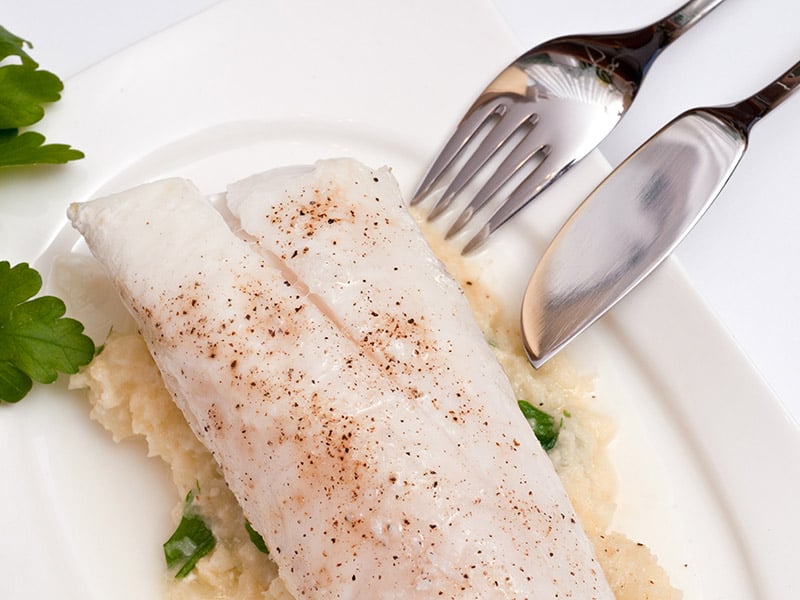
Many people are confused about the purposes of fish knives because of how similar they are to other types of table knives. A fish knife has a surface like a spatula and a sharp point tip.
Simply put, a fish knife on the dining table will remove the skin from the fish and lift the fish meat off the bones. The wide surface also allows easier access to the sauce.
18. Butter Knife
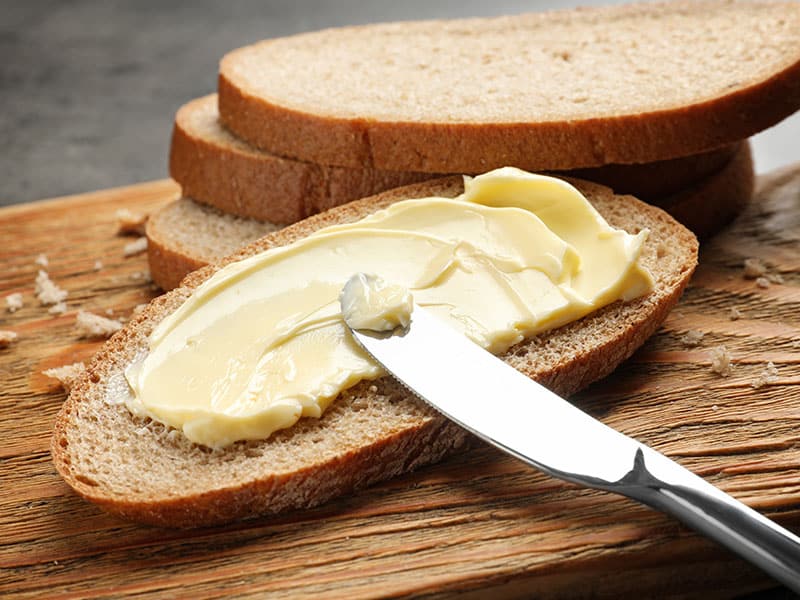
A butter knife, also called a butter spreader, has been common flatware for centuries already. A butter knife is quite similar to a regular silverware knife but comes in a smaller size.
With a rounded or pointed tip and a dull, flat blade, the knife is solely for slicing and spreading butter on bread or any dish. Not only butter, but it can spread any kind of spreadable toppings, like soft cheese, jam, etc.
A modern butter knife has a broader, flexible spatula-like blade, a rounded tip, and a slightly serrated edge. You can use it for almost all toppings on bread, such as butter, cheese, mayonnaise, mustard, and salad toppings.
19. Cheese Knife
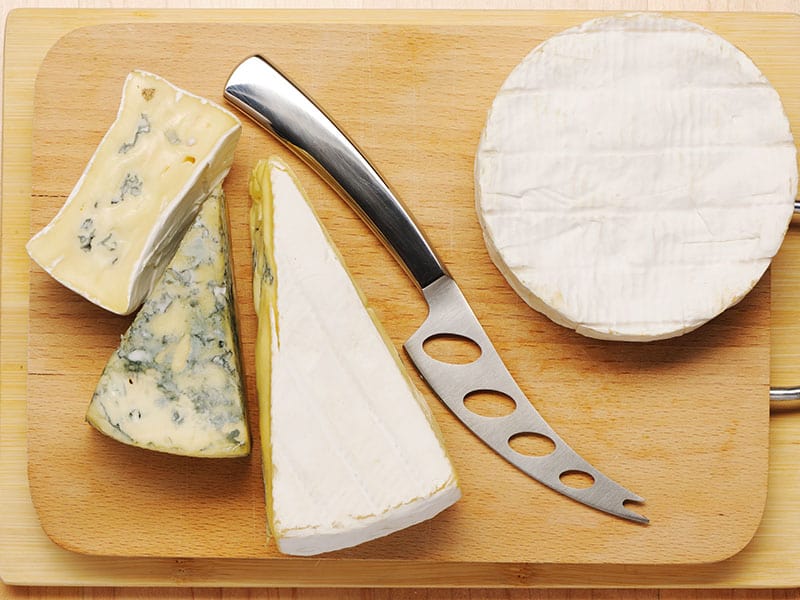
Different types of cheese will require different types of knives. You should be mindful of the sharpness of each type of knife used for the suitable types of cheese.
Soft cheese knives are usually made of stainless steel since that material can withstand cheese’s stickiness. Soft cheese usually sticks to the surface of the knives. Thus knives for soft cheese have holes along the blade to reduce the possibility of stickiness.
Some soft cheese knives have a ridge near the tip of the blade to separate cheese slices when cut. Some have a fork-like tip to move each portion onto another plate.
For hard cheese, you need a tougher type of cheese knife. The blade needs to be tough enough so that it won’t be damaged by hard cheese.
Get to know different cheese knives and their unique purposes.
Some Other Types Of Knives You May Not Know About
This category is for any type of knife that is a bit different. You’re not sure if they’re knives or if they serve different purposes. Rest assured that they work just fine as any other knives.
20. Mezzaluna
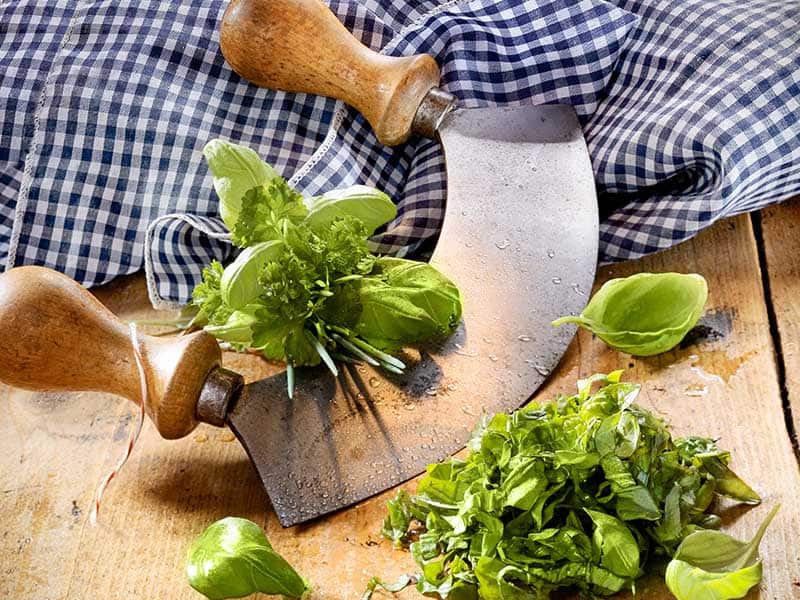
Mezzaluna has one of the most special shapes of any knife. The name, Mezzaluna, which means “half-moon” in Italian, perfectly describes its appearance.
The blade is in a bow shape with handles on each end. The knife usually has 1 blade, but it can also come in 2 or 3 blades.
The shape allows you to evenly mince the ingredients, such as herbs and vegetables, with the rocking motion, making preparing your dishes easier and quicker. It can chop meat and cheese as well.
Mezzaluna is a common kitchen tool in an Italian kitchen. Italian cooks use this knife to prepare ingredients for pesto or sofrito.
It’s easier to mince with Mezzaluna than you thought.
21. Kitchen Shears
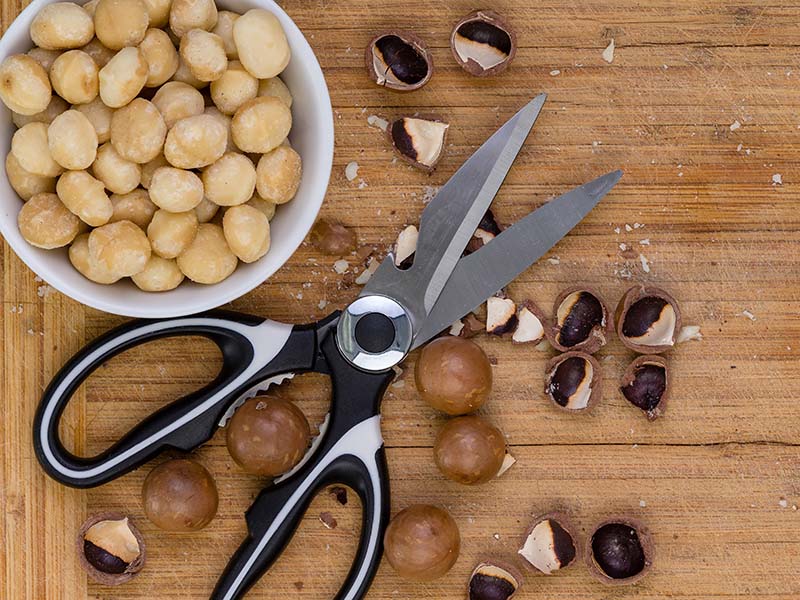
Though not shaped like a knife, kitchen shears can work as a knife just fine. And sometimes, it’s even easier to work with a kitchen shear than a knife!
Kitchen shears are similar to scissors but with thicker and stronger blades to handle work in the kitchen. However, their blades are usually weaker than regular kitchen shears, and it takes more effort and time to sharpen these types of shears.
Kitchen shears are especially for fastly cutting herbs and garlic or onion. But you can also use them to open plastic bags or chop and cut herbs and other meat. Some chefs even crack nuts, open bottles, slice pizza, and scale fish with their shears.
Knife Edge Is The Most Important Part Of A Knife
A knife isn’t completed without a blade, and a blade is no use if it doesn’t have a sharp edge. Let’s find out how many types of edges there are, and what you can do to make use of them.
Straight Edge
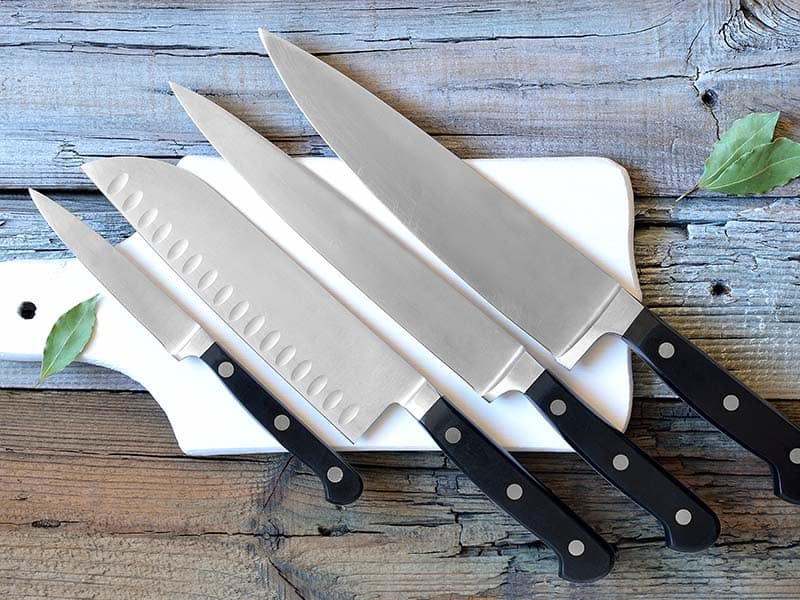
Most knives have a straight edge. For example, chef’s, paring, and utility knives are commonly seen with straight-edge blades.
A straight-edge knife is sharp and easy to use. This type of edge offers a steady and firm pressure when in use, making it more comfortable for you to cut things. You can use it to chop, mince, cut, or slice ingredients.
Serrated Edge
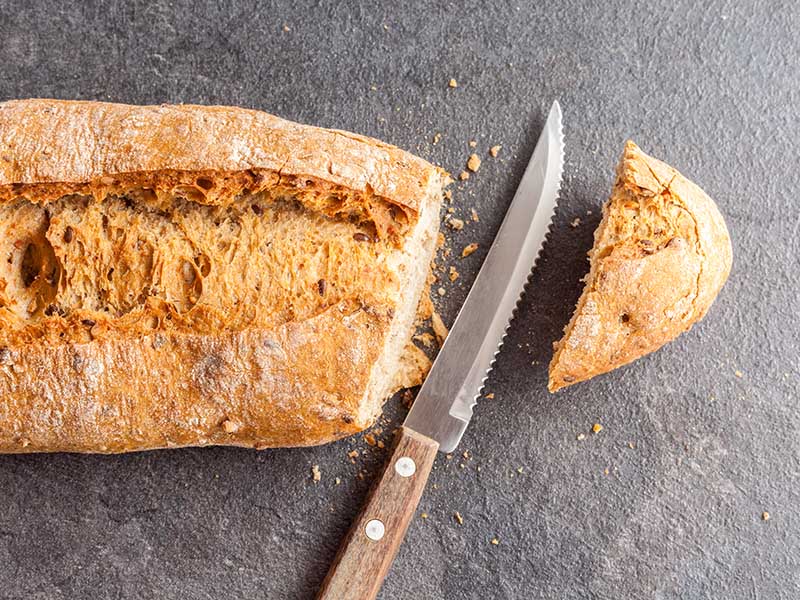
The serrated edge has a blade that looks like “teeth”, with a sharp and rigid blade. The blade design allows you to cut through vegetables and fruits easily without crushing the inside into pieces.
However, it has its disadvantages as well. A serrated-edge knife is hard to take care of and needs several unique kinds of sharpeners. Because of this special blade, the cuts are not as clean as other straight blades. Bread, tomato, and steak knives have this type of edge.
If you still wonder about buying a serrated edge knife, this advice from a chef can help.
Scalloped Edge
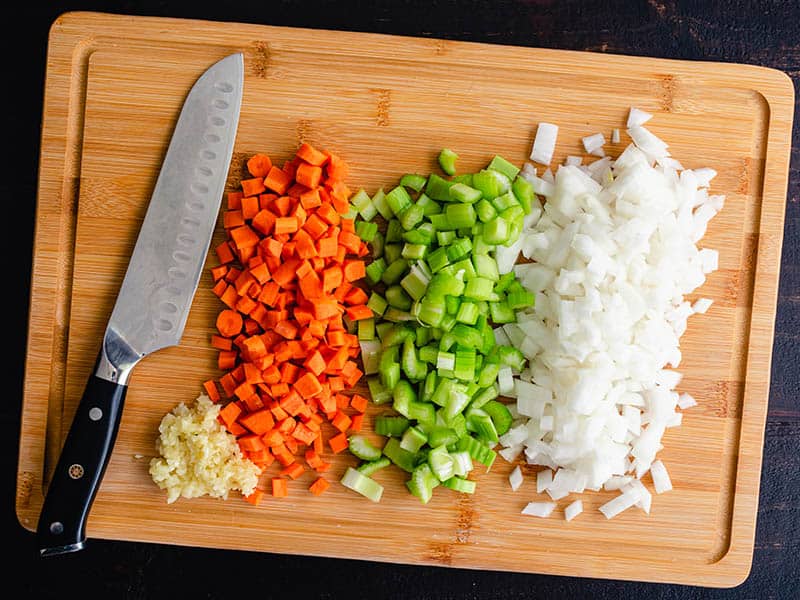
A scalloped edge knife has a series of dimpling along the blade, which helps the food not stick to the knife. This type of knife is perfect for creating thinner and finer cuts of meat and vegetables. Santoku knife and salmon knife are some examples of this type of knife edge.
Hollow Ground Edge
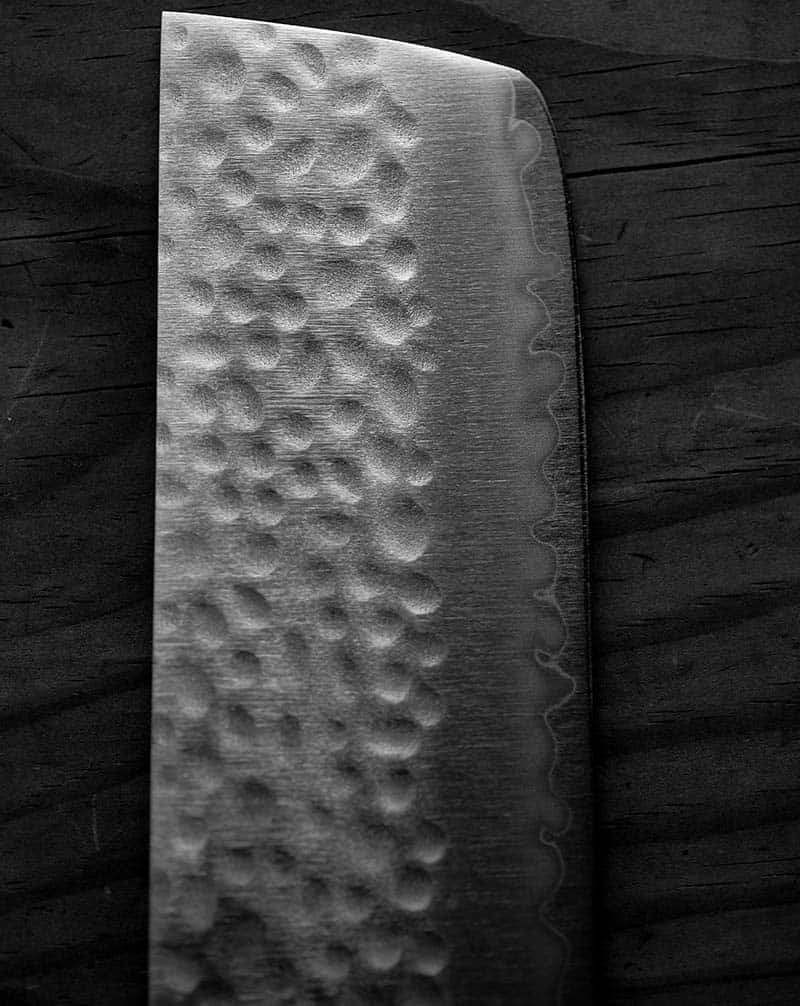
Usually seen in many Japanese knife brands, a hollow ground edge knife has a sharp edge created by the blade’s two sides tapering down the middle.
Because of its thinness, the blade can also be easily breakable, so it needs more care than other knives.
With this type of edge, you won’t have to worry about the reduction in the thinness of the blade because it’ll remain as close to how it was purchased as possible.
Which Material Should You Choose For Your Knife?
Different materials can have different effects on the knife, from its strength and longevity to its sharpness. This section will differentiate each material to craft knives so that you can choose the best knives for yourself.
Carbon Steel
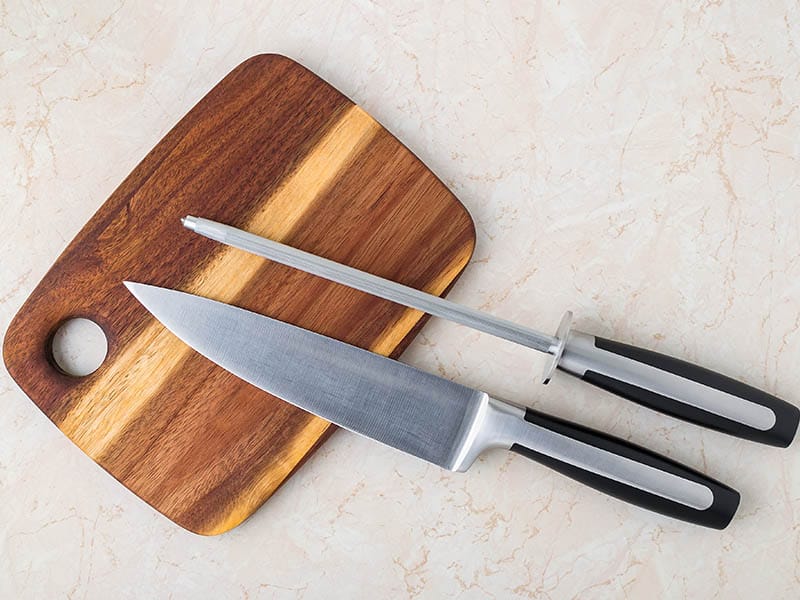
Carbon steel, an alloy of iron and carbon, is the most common material in making knives. Knife smiths have been using this material to make knives for the past few hundred years.
Knives made from this material are usually inexpensive and easy to sharpen, which is why they are in many domestic kitchens. With its outstanding strength and rigidity, it can last for a long time without losing its shape.
However, carbon steel knives can be easily discolored, and the colors can transfer to the food. It can then leave behind an iron taste in your food, especially eggs, onions, and acidic foods.
Carbon steel is perfect for making knives like cleavers or peeling knives.
Stainless Steel

Along with carbon steel, stainless steel is the type of material you can see in most knives. Low-carbon stainless steel is quite softer than carbon steel, so it needs regular sharpening. Their high resistance to corrosion makes them a good choice for kitchenware.
However, stainless steel knives are also easy to blunt and dull, depending on the quality of the material. The shiny exterior and their low price can attract people to buy them, but you’d better buy from qualified brands only.
High-Carbon Stainless Steel
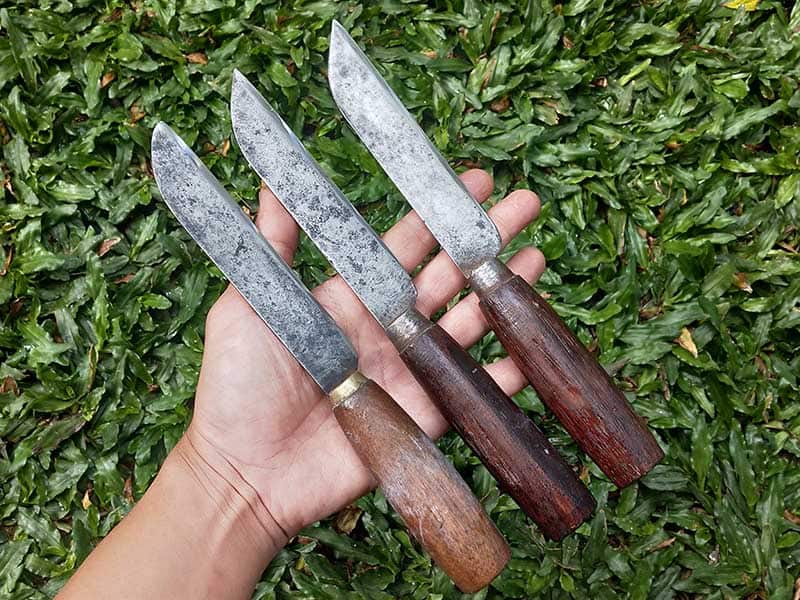
On the contrary, high-carbon stainless steel is more of everyone’s favorite. It’s like the best features of carbon steel knives and stainless steel knives coming together in the knives.
A high-carbon stainless steel knife is a perfect item in your kitchen, wIth longer durability and resistance to corrosion and staining.
Damascus Steel
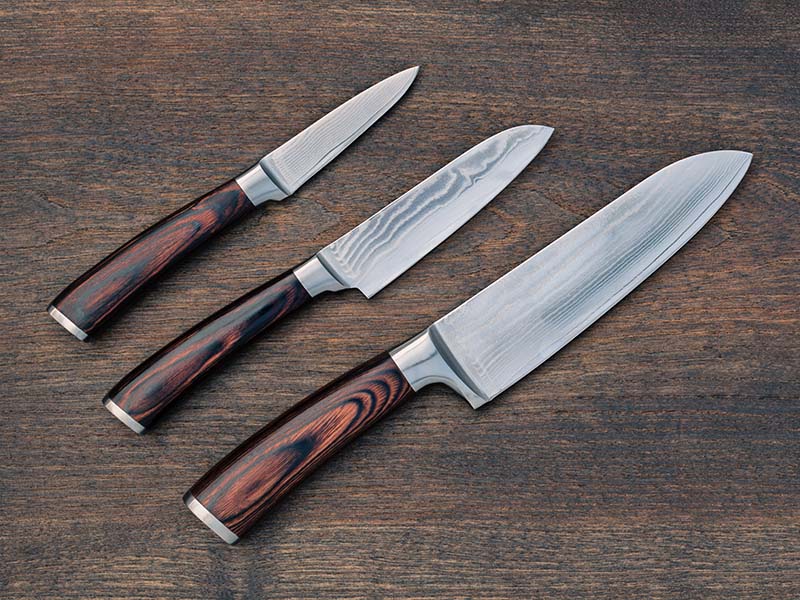
To make Damascus steel knives, you need a special type of steel, with a wavy and intricate pattern. Extremely sharp, durable, and strong, it’s the favorite metal of all knife smiths.
Damascus steel knives are usually expensive due to their complicated crafting process, durability, and beauty.
You’ll understand more about Damascus steel knives after this explanation.
Titanium
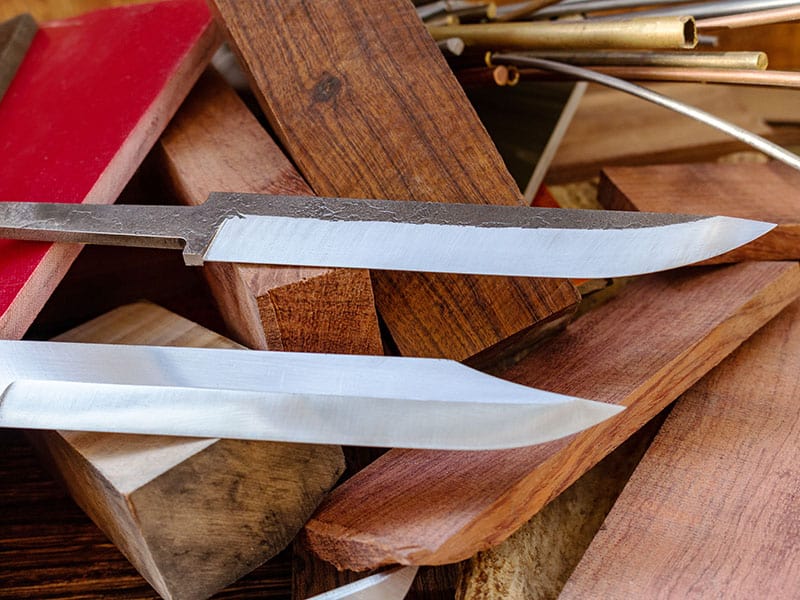
Titanium is one of the hardest and rarest materials, which is why titanium knives are so expensive. They’re more corrosion-resistant and lighter than other materials.
However, titanium knives are more prone to break and difficult to hold an edge, making them a less likely-to-choose option than ceramic or steel knives.
Ceramic
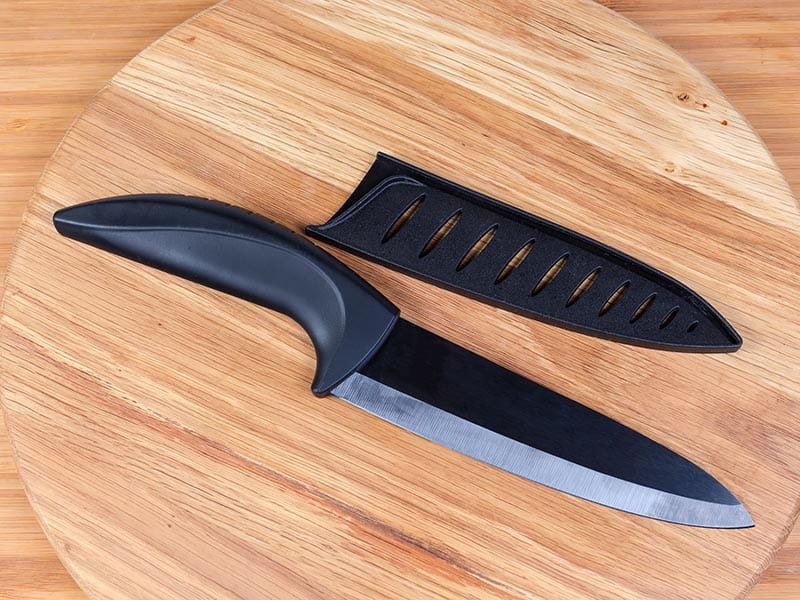
The most common ceramic to make knives is zirconium dioxide. This material prevents the knives from rusting and absorbing smells.
Ceramic knives are very sharp, but when dull, they’re difficult to sharpen. Even though they’re resistant to wear and can last for a long time, you need to handle them with care with how easily breakable they are.
Let’s Pack Up This Essential Kitchen Knives Guide For Your Kitchen
There you have it! The essential kitchen knife guide that you thought you wouldn’t need.
I’ve introduced to you the most important knives in the kitchen and some of the more specialized types for certain purposes. There are tons of brands of essential knife sets in the supermarket that can be a good start for you.
What do you think you need for your kitchen? What are your favorite knives to use daily? Is there any brand in particular that you’d recommend? Please let me know in the comment section below.
If you find this guide to kitchen knives useful, share and subscribe for more interesting tips about knives!

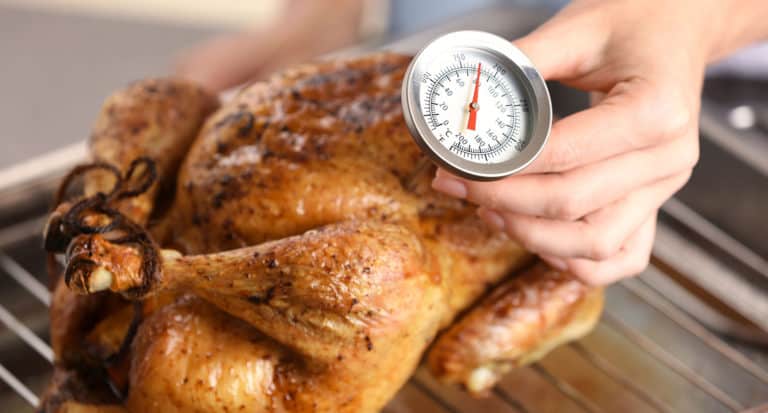
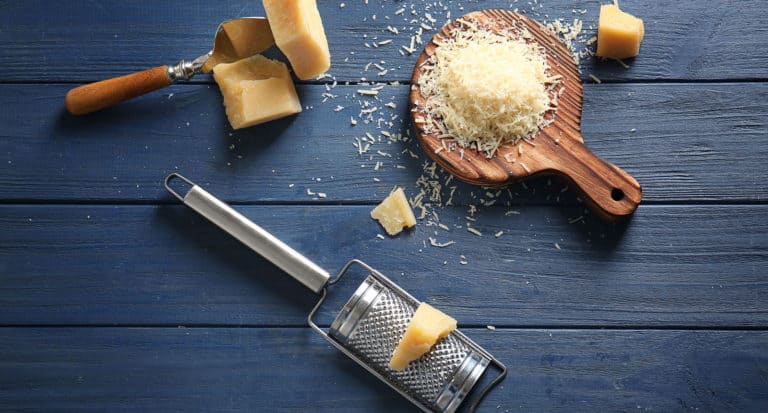
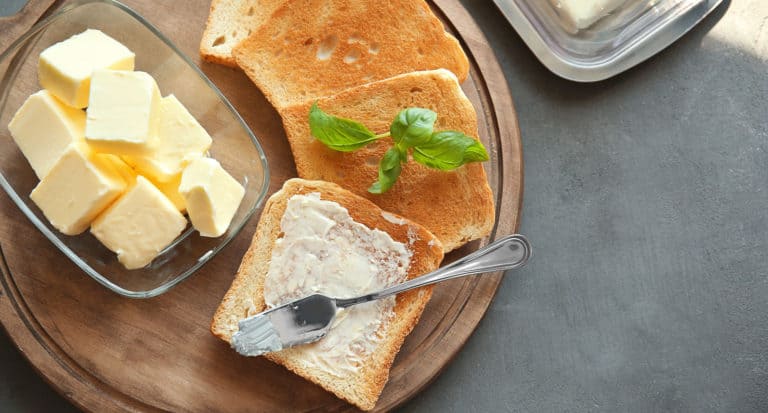
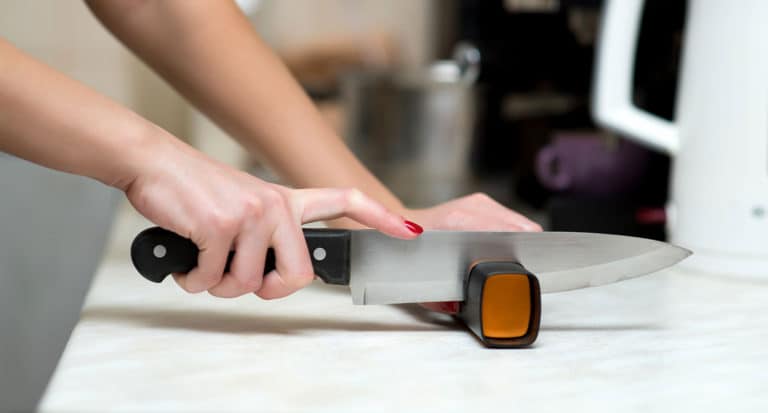
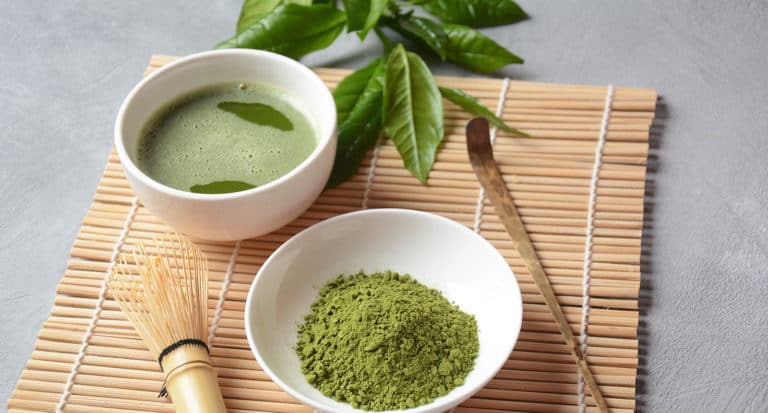
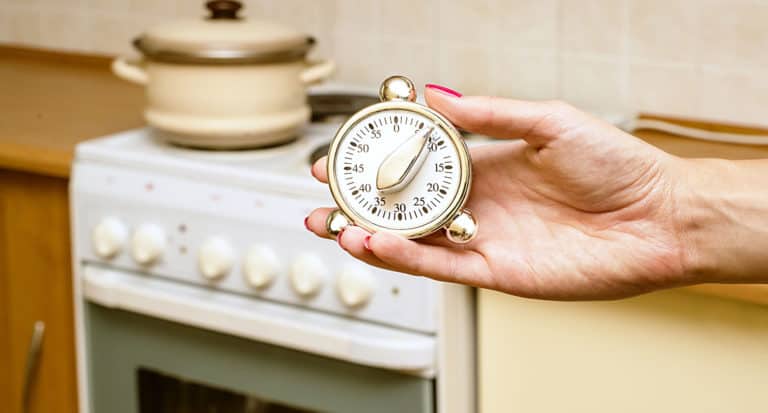
Amanda Collins
Founder and Senior Culinary Editor
Expertise
Culinary Arts and Management, Food Journalism and Critique, Recipe Development and Testing, Global Culinary Traditions, Sustainable Food Practices
Education
Institute of Culinary Education (ICE), New York, NY
Program: Diploma in Culinary Arts
Focus: Intensive hands-on training in culinary techniques, recipe development, and kitchen management, preparing students for professional roles in the culinary industry.
Monroe College, New Rochelle, NY
Program: Associate in Applied Science in Culinary Arts
Focus: Practical culinary skills, including cooking techniques, menu planning, and kitchen operations, with an emphasis on hands-on experience and industry standards.
Amanda Collins is a seasoned chef and food editor with a deep love for global flavors. Trained at the Institute of Culinary Education and Monroe College, and with over 15 years in the culinary field, Amanda has refined her skills in kitchens worldwide. Her background in food studies gives her a unique ability to share both recipes and the cultural stories that shape them.
As senior culinary editor at thebreslin.com, Amanda’s work brings authentic dishes to life, inviting readers to explore new flavors and techniques from around the globe. Her approachable style makes it easy for anyone to bring a bit of the world’s cuisine into their kitchen.